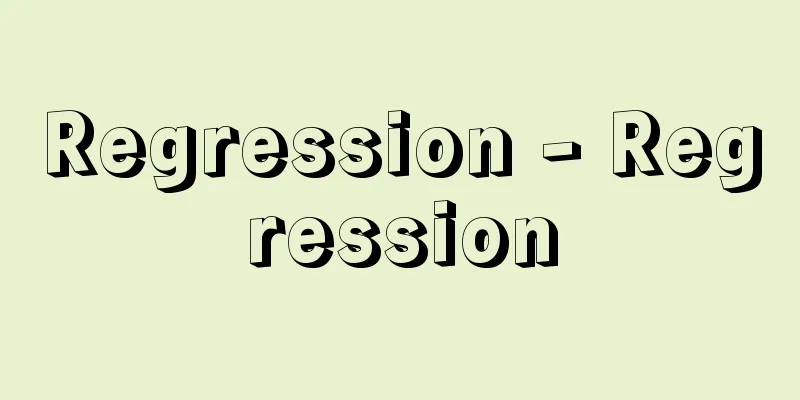Unemployment - English spelling: unemployment

|
It refers to the state of the working population in which people have the ability and will to work but are unable to obtain work opportunities, and is a social phenomenon inevitable in capitalism. Possession of the ability to work means having the ability to do simple work, except in cases such as incapacity to work or recuperation from illness, and possession of the will to work means expressing a willingness to work, even if only passively, except in cases of conscious aversion to work, such as workers in disputes. Furthermore, the presence or absence of work opportunities, if interpreted literally, means whether or not one can obtain the opportunity to work, but it should also be understood from the perspective of whether or not the employment is appropriate for each individual's ability and will to work. In cases of involuntary short-term employment or irregular employment with interruptions to employment, there are cases where people are essentially close to being unemployed, even if they are working, and this is called semi-unemployment. In addition, the state in which people want to work but have given up on job hunting because there are no suitable jobs for them is called potential unemployment. In a capitalist economy, it is not possible to fundamentally eliminate unemployment and semi-unemployment, but it is possible to reduce the degree of unemployment and semi-unemployment through policies. [Mitomi Noritaka and Goga Kazumichi] The formation and function of relative surplus populationFor a long time in the history of economics, unemployment and semi-unemployment have been considered to be "absolute" excess population for society. Malthus, in his On the Principle of Population (1798), explained excess population from the imbalance between the geometrically increasing population and the arithmetically increasing food supply, and considered this to be a natural law that permeates history. J. S. Mill, in his Principles of Economics (1848), argued that the amount of capital paid as wages is a constant fund at a given point in time, and therefore the wage rate is directly proportional to the amount of capital and inversely proportional to the number of workers. This wages fund theory is the origin of the idea that unemployment is caused by high wages, minimum wage systems, or the existence of labor union wage agreements. In response to these, Ricardo revised his views from the second edition of Principles of Political Economy and Taxation (1819) in the third edition (1821), stating that the introduction of machinery in a country with a constant total capital eliminates labor and creates an excess population, and that if capital accumulation is accompanied by the introduction or expansion of the use of machinery, the demand for labor will only increase at a decreasing rate. Marx critically inherited Ricardo's views and systematized the theory of relative surplus population (Capital, Vol. 1, 1867). The key concept at that time was the "advanced organic composition of capital." As productivity improved and capitalism developed, the scale of production means such as machinery and factories became much larger than the labor force employed there, and the capital invested in the former (constant capital) exceeded the capital used to pay wages (variable capital). For example, if half of the invested capital was once allocated to the means of production and the other half to wages, now 90% goes to the former and only 10% to wages. The ratio of constant capital to variable capital, which reflects the technical ratio of the means of production and labor, is the organic composition of capital. As this ratio becomes more sophisticated (from 1:1 to 9:1 in the previous example), the number of workers per unit of capital decreases, and workers who are no longer needed lose their jobs and are forced into a relative surplus population (unemployed and semi-unemployed). If the rate of increase in the total amount of capital exceeds the speed of the advancement of the organic composition of capital, the number of employed workers may increase, so the advancement of the capital composition does not immediately lead to the formation of a relative surplus population. However, while the advancement of the capital composition in one sector is rapidly progressing, it may remain the same in another sector, or there may be a situation in which capital concentration (mergers) progresses with the total amount of capital in society remaining constant, which leads to the advancement of the organic composition of capital and a surplus of workers. Capital accumulation, taking into account these various factors, gives rise to a relative surplus population. Once a relative surplus population is formed, it becomes a condition that supports capital's sudden expansion of production. Regardless of the actual population increase, the surplus population that capital can freely use at any time functions as an industrial reserve army. The industrial reserve army suppresses the rise in wage levels that accompanies an increase in labor demand, and also puts pressure on employed workers to work long hours and in excessive numbers. This also becomes a factor in increasing the relative surplus population. Therefore, how labor standards regarding working hours and labor intensity are set is deeply related to the formation of the relative surplus population. Regulating excessive work and establishing labor standards is an essential task not only for regulating a society of overwork, but also for improving the problem of unemployment. [Mitomi Noritaka and Goga Kazumichi] New factors causing unemployment and semi-unemploymentToday's unemployment and semi-unemployment is created by the basic factors mentioned above, plus new ones. First, production expands dramatically based on the rapid development of production technology and information networks, but is constrained by limited markets (consumption), and there is always the possibility of it causing a recession or depression. Governments try to avoid recessions through fiscal and monetary policies, but it is impossible to eliminate them fundamentally. Since it is not easy to streamline excess machinery and equipment, recovery from a recession is often prolonged, and the increase in unemployment becomes chronic. As the recession continues for a long time, companies step up personnel reductions (restructuring) in order to reduce labor costs in order to restore profits, which creates unemployment. Secondly, because companies that implement restructuring tend to see their stock prices rise based on the perception that their profitability will increase, even companies that are performing well may reduce their workforce from a management strategy perspective. Corporate managers who prioritize shareholder interests tend to ignore the basic rights of workers and implement restructuring solely in response to pressure from shareholders. Thirdly, today's unemployment and semi-unemployment are deeply connected to the business strategies of multinational corporations. Following the principle of "optimal location" - expanding business in the most advantageous countries and regions - companies have come to freely cross borders. This strategy of multinational corporations has brought about the hollowing out of industry and has had a huge impact on national economies, disrupting domestic markets through the re-importation of low-priced goods produced in the countries they have expanded into. This has led to a shrinkage of domestic employment and an increase in the number of unemployed. Fourth, the overseas expansion of multinational corporations has shaken the business base of traditional industries and self-employed people in the developing countries they operate in, forcing the people who were employed there into surplus population in big cities. Furthermore, multinational corporations have created new unemployment problems by moving their factories to other developing countries in search of cheaper labor. Such strategies of multinational corporations have created unstable employment opportunities in the countries they operate in, while at the same time increasing unemployment and semi-employment. Some of this surplus population is flowing into developed countries as foreign workers. Foreign workers who come to developed countries through legal or illegal routes are incorporated into the bottom of the labor market, becoming part of non-regular employment, or remaining as active or potential unemployed, amplifying the unemployment problem in developed countries. [Mitomi Noritaka and Goga Kazumichi] The theory of unemployment in modern economicsModern economics considers that in a competitive labor market, wages and employment volume are determined by the point where labor demand and supply match. If the wage level becomes high for some reason, and the labor supply (the number of workers seeking work) increases and exceeds the demand (the number of job openings), unemployment will occur, but eventually the supply will decrease, wages will fall, and unemployment will be eliminated as supply and demand match. Therefore, as long as wages are sufficiently lowered, unemployment will not occur for a long time. However, if wages do not fall below a certain level due to resistance from labor unions, etc. (downward wage rigidity), unemployment will occur if there is insufficient labor demand to match them. J.M. Keynes, assuming downward wage rigidity, explained the unemployment during the Great Depression of the 1930s in terms of a lack of total demand, and saw the cause in the failure to achieve the production level necessary to realize a state in which all workers who are willing to work are employed (full employment). To overcome this, he proposed demand through government fiscal expenditure, i.e., public works (The General Theory of Employment, Interest and Money, 1936). Keynes's theory of effective demand became the theoretical underpinning of the full employment policies adopted in advanced capitalist countries after World War II. In labor economics, which is based on modern economics, unemployment caused by a mismatch between job offers and job seekers (in terms of age, gender, job type, skills, region, etc.) is called structural unemployment, unemployment that occurs for a certain period of time because job/job search information is difficult to obtain or because it takes time for labor to move is called frictional unemployment, and unemployment caused by a lack of employment opportunities such as corporate job offers is called demand-deficient unemployment. [Mitomi Noritaka and Goga Kazumichi] Unemployment and semi-employment in Western countriesThe number of unemployed and the unemployment rate in each country have increased significantly since the Great Recession of 1974-1975. In the 1980s, some countries recorded unemployment rates of 10%, reaching the level of the 1930s during the Great Depression. As the European Parliament acknowledges, the actual number of unemployed is far higher than the government's unemployment statistics. The European Trade Union (ETUC) claims that workers who are not eligible for unemployment benefits and have little hope of finding work do not appear in unemployment statistics, and that the number of unemployed in the European Community (now the European Union) as of the first half of 1982 was 13 million if the 2 million "hidden unemployed," including young people, elderly people, and married women, were included in addition to the 11 million who could be counted in official statistics. Unemployment tends to be relatively concentrated among those without qualifications or with low professional qualifications, but it also affects those with high technical qualifications. The background to this seriousness of the unemployment problem is the major change in corporate investment trends that occurred in the 1970s. With excess capital becoming apparent, the expansion of profits came to depend on speculation rather than productive investment. Even when productive investment was made, investment overseas was expanded while domestic investment was restrained. The limited amount of domestic investment placed emphasis on labor-saving investment. As a result, while restructuring was carried out domestically, employment was also expanded overseas. New hiring by companies was generally sluggish, and many employment arrangements were unstable, such as fixed-term contracts, further aggravating the unemployment problem. Even since the 1990s, Western developed countries have had a large number of unemployed people. In particular, the number of unemployed people in OECD (Organization for Economic Cooperation and Development) member countries increased sharply from 2008 (32.3 million) to 2009 (44.05 million) due to the impact of the global recession triggered by the 2008 US financial crisis. The unemployment rates according to ILO (International Labor Organization) standards as of 2008 were 11.4% in Spain, 7.9% in France, 7.3% in Germany, 7.0% in Belgium, 6.8% in Italy, 6.1% in Canada, 5.8% in the US, and 5.6% in the UK. Japan's rate was 4.0%. [Mitomi Noritaka and Goga Kazumichi] Unemployment and semi-employment in JapanJapan's unemployment rate and the number of unemployed people are surveyed monthly by the Statistics Bureau of the Ministry of Internal Affairs and Communications. In order to be counted as unemployed in the Labor Force Survey, a person must not have been employed for even one hour during the survey period (the week before the end of the month), must be currently seeking employment, must be available to start work if a job becomes available, and must be actively searching for work or waiting for the results of a previous job search. Those who are actually unemployed but have given up on job hunting due to the lack of available work due to their age or occupation, or those who only worked part-time for a short time during the survey period, are not counted as unemployed. For this reason, the number of unemployed people in Japan is understated. The unemployment rate is calculated by dividing the number of unemployed people by the labor force (the number of unemployed people + the number of employed people). During the period of high economic growth from the late 1950s to the early 1970s, low unemployment continued, but the shift to a low-growth economy following the first oil crisis (1973) led to the number of unemployed exceeding one million after 1975. After that, both the number of unemployed and the unemployment rate continued to increase, and although there was a temporary decrease during the bubble economy period from the late 1980s to the early 1990s, the number of unemployed exceeded two million in 1995 (Heisei 7) amid a prolonged recession following the collapse of the bubble economy. With a succession of personnel cuts due to corporate restructuring, the number of unemployed exceeded three million in 1999, and the unemployment rate fell to the 5% range in July 2001. During the period of economic prosperity from 2002 to 2007, the unemployment rate fell, but then rose again, reaching 5.1% in 2009. From the 1990s to the beginning of the 21st century, against the backdrop of corporate employment strategies that sought greater flexibility and flexibility in employment amid global competition, and the deregulation policies of labor laws that supported these strategies (such as successive revisions to the Worker Dispatch Law), there was a noticeable increase in non-regular employment, such as part-timers and dispatched workers. Many non-regular employees have limited employment terms and are unstable (semi-unemployed), with people alternate between employment and unemployment. According to the Ministry of Internal Affairs and Communications' Basic Survey on Employment Structure (2007), non-regular employment accounts for over 35% of all workers. [Mitomi Noritaka and Goga Kazumichi] Japan's employment and unemployment measuresIn Western countries, dismissal regulations that stipulate the legitimate reasons, procedures, criminal and civil penalties, and compensation for dismissed workers are widespread. In Japan, on the other hand, there are only provisions prohibiting dismissal for union membership or union activities (Article 7 of the Labor Union Law) and prohibiting dismissal of workers on leave due to industrial accidents or occupational illness (including the 30 days thereafter) and female workers on maternity leave (Article 19 of the Labor Standards Law), but no measures were taken to generally regulate dismissal. Finally, in the 2003 amendment to the Labor Standards Law, a clause was added stating that "if a dismissal lacks objectively reasonable grounds and is not deemed appropriate according to social standards, it shall be deemed an abuse of rights and shall be invalid." This clause was then moved to Article 16 of the Labor Contract Law, which was enacted in 2007. In Japan, the Employment Insurance Act (Law No. 116 of 1974) established the Employment Adjustment Benefits System (later the Employment Adjustment Subsidy System), which provides government subsidies for part of the leave allowances paid to workers when struggling companies temporarily close. Unemployment benefits, which provide income security for the unemployed, are generally shorter than those in Western countries, and the amount of benefits is low because the principle of minimum income security has not been established. Since the law does not effectively guarantee the freedom of occupational choice for the unemployed, they are forced to take jobs with poor working conditions and instability. In Western countries, the institutionalization of public employment programs and measures to reduce working hours have been implemented with the aim of creating employment opportunities for the unemployed, and have been effective to a certain extent. In contrast, in Japan, public unemployment countermeasures programs have been abolished, and the reduction of working hours is left to the discretion of companies. [Kazumichi Goga and Noritaka Mitomi] "Capitalism and Unemployment" edited by Kishimoto Eitaro (1957, Nippon Hyoron Shinsha) " ▽ "Economic Analysis of Employment and Unemployment" by Oki Kazunori (1979, Otsuki Shoten)" ▽ "Unstable Employment in Modern Japan, Volumes 1 and 2, by Kato Yuji (1980, 1982, Ochanomizu Shobo)" ▽ "Modern Unemployment" edited by Koike Kazuo (1984, Dobunkan Shuppan)" ▽ "The Politics and Economics of the Unemployment Problem" edited by Kase Kazutoshi and Tabata Hirokuni (2000, Nippon Keizai Hyoronsha)" ▽ "Introduction to Labor Economics" by Ota Soichi and Tachibanaki Toshiaki (2004, Yuhikaku)" ▽ "The Age is Like Capital" edited by the Institute for Basic Economic Science (2008, Showado)" ▽ "Databook of International Labor Comparison 2010" edited and published by the Japan Institute for Labor Policy and Training (2010) [References] | | | | | | | | | | | |Source: Shogakukan Encyclopedia Nipponica About Encyclopedia Nipponica Information | Legend |
|
労働の能力と意思をもちながら労働の機会を得ることのできないでいる労働人口の状態をいい、資本主義に必然的な社会現象である。労働能力の保有とは、労働不能や病気療養中などの場合を除いて簡単な労働を行う能力を備えていることであり、また、労働意思の保有とは、争議中の労働者のような意識的な労働忌避などの場合を除いて、消極的にしろ就労の意欲を表明していることである。さらに労働機会の有無とは、字義どおりに解するならば就労の機会自体を得ることができるかどうかということであるが、さらに広く個々の労働能力と意思とに相応する就労であるか否かという観点からもとらえるべきである。非自発的な短時間雇用や雇用の中断を伴う不規則な雇用は就労していても実質的には失業状態に近いケースがあり、これを半失業という。また、働くことを望んでいるにもかかわらず自分にふさわしい職がないため求職活動をあきらめている状態を潜在的失業という。資本主義経済では失業および半失業を根本的になくすことはできないが、政策によって失業や半失業の度合いを軽減することは可能である。 [三富紀敬・伍賀一道] 相対的過剰人口の形成と作用失業および半失業は、経済学の歴史のうえでは長い間社会にとって「絶対的」に過剰な人口である、と考えられてきた。マルサスは『人口の原理』(人口論、1798)において、幾何級数的に増加する人口と算術級数的にしか増加しえない食糧との不均衡から人口の過剰を説き、これを歴史を貫く自然法則であるとした。J・S・ミルは『経済学原理』(1848)において、賃金として支払われる資本量は一定の時点では一定した基金であり、このため賃金率は資本量に正比例し労働者数に逆比例する、と説いた。この賃金基金説wages fund theoryは、失業が生ずる原因を労働者の高賃金や最低賃金制あるいは労働組合の賃金協定の存在に求める考え方の源流である。 これらに対してリカードは『経済学および課税の原理』第3版(1821)において、『同』第2版(1819)までの見解を修正し、一国の資本総額一定のもとでの機械の導入は、労働を排除して人口を過剰にするとしたうえで、資本の蓄積が機械の導入もしくは使用の拡大を伴って行われる場合には、労働需要は逓減(ていげん)する割合でしか増大しない、と説いた。マルクスは、リカードの見解を批判的に継承して相対的過剰人口の理論を体系化した(『資本論』第1巻・1867)。その際にキーワードとなったのが「資本の有機的構成の高度化」という概念である。生産力が向上し資本主義が発展するにつれ、機械設備や工場などの生産手段の規模は、そのもとで就労する労働力に比べはるかに大きく、前者に投下された資本(不変資本)は賃金支払いにあてられる資本(可変資本)を上回るようになる。たとえば投下資本のうち、かつては半分が生産手段に、残り半分が賃金にあてられていたのに、いまでは9割が前者に、賃金にはわずか1割しか投下されないというようになる。このように生産手段と労働力の技術的比率を反映した不変資本と可変資本の比が資本の有機的構成である。これが高度化するに伴って(先の例のように1:1が9:1になること)同一資本規模当りの労働者数は減少し、不要になった労働者は職を失い、相対的過剰人口(失業および半失業)に追いやられる。資本総量の増加率が資本の有機的構成高度化のスピードを上回るならば、雇用される労働者数は増加することもあるため、資本構成の高度化からただちに相対的過剰人口の形成を導くことはできない。しかし、ある部門で資本構成の高度化が急速に進んでいるときに、別の部門では従来のままということもあるし、また社会全体の資本総量が一定のもとで、資本の集中(企業合併)が進み、それに伴って資本の有機的構成の高度化が進行し、労働者の過剰が発生するという事態もある。資本蓄積はこのような諸契機を含みつつ、相対的過剰人口を生み出すようになる。 ひとたび形成された相対的過剰人口は、資本の突発的な生産拡大を支える条件となる。現実の人口増加にかかわりなく、いつでも資本が自由に利用しうる過剰人口は産業予備軍としての機能を担う。労働需要の増加に伴う賃金水準の上昇は産業予備軍によって抑制され、また、産業予備軍は就業している労働者に対して長時間過密労働を迫る圧力となる。これは相対的過剰人口を増加させる要因ともなる。そのため、労働時間や労働強度に関する労働基準がどのように設定されているかは相対的過剰人口の形成にも深くかかわっている。過度労働を規制し、労働基準を確立することは働きすぎ社会を規制するためのみならず、失業問題の改善にとっても不可欠の課題である。 [三富紀敬・伍賀一道] 失業・半失業をつくりだす新たな要因今日の失業および半失業は上記の基本的な要因に新たな点が加わってつくりだされている。 第一に、生産技術や情報ネットワークの飛躍的発展を基礎として生産は飛躍的に拡大するが、限られた市場(消費)によって制約され、不況や恐慌を引き起こす可能性を絶えずはらんでいる。政府は財政・金融政策によって不況の回避を図るが、根本的に除去することは不可能である。過剰となった機械設備の整理は容易でないため、不況局面からの回復はしばしば長引き、失業者の増加は慢性化するようになる。不況が長期化するもとで企業は収益回復のために労働コストの削減を目ざして人員削減(リストラ)を強めるため失業者が生み出される。 第二に、リストラを実施する企業は収益力が強まるとの評価に基づいて株価が上昇する傾向があるため、好業績をあげている企業でも経営戦略の観点から人員削減が行われることがある。株主の利益を最優先する企業経営者の場合、労働者の基本的権利を軽視して、もっぱら株主の圧力に従ってリストラを実施する。 第三に、今日の失業・半失業は多国籍企業の経営戦略と深くかかわっている。もっとも有利な国や地域で事業を展開する「最適地主義」の原理に従って、企業は自由に国境を越えるようになった。このような多国籍企業の戦略は産業空洞化をもたらすとともに、進出先で生産した低価格商品の逆輸入を通して国内市場を攪乱(かくらん)するなど、国民経済に多大な影響を及ぼしている。これによって国内雇用は縮小し失業者を増加させる。 第四に、多国籍企業の海外展開は進出先である発展途上国の伝統的産業や自営業者の経営基盤を揺るがし、そこで就労していた人々を大都市の過剰人口に追いやる要因となっている。さらに、多国籍企業がより安価な労働力を求めて別の途上国に工場を移すことで新たな失業問題を生み出している。多国籍企業のこのような戦略は、進出先の諸国に不安定な雇用機会を生み出しつつ、同時に失業・半失業を増加させている。これらの過剰人口の一部は外国人労働者として先進国に流入している。合法または非合法のルートを通して先進国にやってくる外国人労働者は労働市場の最底辺に編入され、非正規雇用の一員となるか、あるいは顕在的、潜在的失業者として滞留し、先進国の失業問題を増幅している。 [三富紀敬・伍賀一道] 近代経済学の失業理論近代経済学では、競争的労働市場のもとでは労働の需要と供給が一致する点で賃金と雇用量が決定されると考える。なんらかの事情で高い賃金水準になった場合、労働供給(仕事を求める労働者数)が増加し需要(求人数)を上回るようになれば失業が生まれるが、やがて供給が減少、賃金が低下し需給が一致するため失業は解消される。したがって賃金が十分に低下する限り失業が長期にわたって発生することはない。しかし、労働組合の抵抗などによって一定の水準以下に賃金が低下しない場合(賃金の下方硬直性)、それに見合う労働需要が十分でないならば失業が発生する。J・M・ケインズは賃金の下方硬直性を前提にして、1930年代の大不況期の失業を総需要の不足から説明し、働く意思のあるすべての労働者が雇用される状態(完全雇用)を実現するために必要な生産水準が達成されないことにその原因をみた。その打開に向けて提起されたのが政府の財政支出による需要、すなわち公共事業である(『雇用・利子および貨幣の一般理論』1936)。ケインズの有効需要の理論は第二次世界大戦後の先進資本主義国で採用された完全雇用政策の理論的支柱となった。 なお、近代経済学に基づく労働経済学では、求人および求職のミスマッチ(年齢、性、職種、技能、地域など)によって生ずる失業を構造的失業、求人・求職情報が入手困難なため、あるいは労働移動に時間がかかるため一定期間発生する失業を摩擦的失業、さらに企業の求人など就労機会の不足によって生まれる失業を需要不足失業とよんでいる。 [三富紀敬・伍賀一道] 欧米諸国の失業・半失業各国における失業者数および失業率は、1974~1975年の世界同時不況以降著しく増加している。1980年代に入ると10%の失業率を記録する国も現れ、失業者数は世界恐慌下の1930年代の水準に達した。ヨーロッパ議会European Parliamentも認めるように、実際の失業者数は政府の失業統計をはるかに上回っている。ヨーロッパ労連(ETUC)は、失業手当を受けることができず、仕事をみつける望みに乏しい労働者は、失業統計に現れてこないとして、1982年上半期の時点でヨーロッパ共同体(現ヨーロッパ連合)の失業者数は、公式統計で把握できる1100万人のほかに、若年者をはじめ高齢者、既婚女性などの「隠れた失業者」200万人を含めるならば、合計1300万人になるとした。 失業は、無資格もしくは職業資格の低い者に相対的に集中する傾向にあるが、高い技能の資格をもつ者にも及んでいる。失業問題がこのように深刻化した背景には、企業の投資動向が1970年代に入って大きく変化したことがあげられる。過剰資本の顕在化するもとで、利潤の拡大が、生産投資ではなく投機という方法に依存するようになったこと、生産投資が行われる場合にも国内で手控えるかわりに国外における投資が拡大されること、限られた範囲の国内投資も省力化のための投資を重点にしていることなどによる。この結果、国内においてリストラをする一方で、国外で雇用を拡大するということも行われている。企業による新規の採用は全体として低調で、期間の定めのある契約などの不安定な雇用形態が多く、失業問題をさらに深刻化させている。 1990年代以降も欧米先進諸国では多数の失業者を抱えている。とりわけ2008年のアメリカの金融危機を契機とする世界同時不況の影響を受けて、OECD(経済協力開発機構)加盟国の失業者数は2008年(3230万人)から2009年(4405万人)にかけて急増した。2008年時点のILO(国際労働機関)基準による各国の失業率はスペイン11.4%、フランス7.9%、ドイツ7.3%、ベルギー7.0%、イタリア6.8%、カナダ6.1%、アメリカ5.8%、イギリス5.6%などである。なお日本は4.0%であった。 [三富紀敬・伍賀一道] 日本の失業・半失業日本の完全失業者および完全失業率は、総務省統計局「労働力調査」が毎月調査している。「労働力調査」で完全失業者に数えられるためには、調査期間(月末1週間)のうち1時間といえども就業していてはならないことをはじめ、現に就業を希望していること、仕事があればすぐにでも就業できる状態にあること、しかも実際に求職活動をしているか、または過去に行った求職活動の結果を待っていること、という条件を満たさなければならない。実際に失業状態にあっても、年齢や職種などで自分に就労可能な職がないため求職活動を断念した人や、調査期間中にごく短時間アルバイトをした人などは完全失業者にカウントされない。このため、日本の失業者数は実態より過少に表示されている。なお、完全失業率は、完全失業者を労働力人口(完全失業者+就業者)で除して算出する。 1950年代後半から1970年代初頭までの高度成長期には低失業状態が続いていたが、第一次石油危機(1973)を契機とする低成長経済への転換によって1975年以降、完全失業者は100万人を突破した。その後、完全失業者、完全失業率ともに増加を続け、1980年代末から1990年代初頭にかけてのバブル経済期には一時減少したものの、バブル経済の破綻(はたん)以降、不況が長期化するもとで1995年(平成7)には完全失業者は200万人を超えた。企業のリストラによる人員削減が相次ぎ、1999年に入ると完全失業者は300万人を突破し、2001年7月には完全失業率は5%台に突入した。2002年から2007年にかけての好況期には完全失業率は低下したが、その後、ふたたび上昇し2009年に5.1%になった。 1990年代から21世紀初頭にかけて、グローバル競争のもとで雇用の弾力化・柔軟化を求める企業の雇用戦略とそれを支援した労働法制の規制緩和政策(労働者派遣法の相次ぐ改正など)を背景に、パートタイマーや派遣労働者などの非正規雇用の増加が顕著になった。非正規雇用の多くは雇用期限が限られ、就業と失業を繰り返す不安定雇用(半失業)である。総務省の「就業構造基本調査」(2007)によれば非正規雇用は全労働者の35%余に達している。 [三富紀敬・伍賀一道] 日本の雇用・失業対策西欧諸国では、解雇について、正当な事由、手続、刑事上・民事上の罰則、被解雇者への補償などを定めた解雇規制法が広く普及している。一方日本では、労働組合への加入や組合活動を理由とする解雇禁止の規定(労働組合法7条)や、労働災害や職業病のため休業中(その後30日間を含む)の労働者および産前産後休業中(同)の女性労働者の解雇を禁止する規定(労働基準法19条)が設けられただけで、解雇を一般的に規制する措置はとられていなかった。ようやく2003年の労働基準法改正で「解雇は、客観的に合理的な理由を欠き、社会通念上相当であると認められない場合は、その権利を濫用したものとして、無効とする」という条項(同法18条2)が設けられた。その後、この条項は2007年に制定された労働契約法第16条に移された。 日本では雇用保険法(昭和49年法律第116号)によって、経営不振の企業が一時休業をした場合、労働者に支払う休業手当の一部を国が補助する雇用調整給付金制度(後に雇用調整助成金制度)が開始された。失業者に対する所得保障である失業給付は、欧米諸国の給付期間に比べて概して短く、最低所得保障原則が確立されていないため給付額は低い。失業者の職業選択の自由を実質的に保障する役割を果たしていないため、労働条件が低く不安定な仕事であってもやむなく就労せざるをえない状況にある。 欧米諸国では、公的就労事業の制度化や労働時間の短縮の措置が、失業者への雇用機会の創出という観点から進められ、一定の効果をあげてきた。これとは逆に日本では、公的失業対策事業は廃止され、また、労働時間の短縮についても企業の裁量にゆだねられている。 [伍賀一道・三富紀敬] 『岸本英太郎編『資本主義と失業』(1957・日本評論新社)』▽『大木一訓著『雇用・失業の経済分析』(1979・大月書店)』▽『加藤佑治著『現代日本における不安定就業労働者』上下(1980、1982・御茶の水書房)』▽『小池和男編著『現代の失業』(1984・同文舘出版)』▽『加瀬和俊・田端博邦編著『失業問題の政治と経済』(2000・日本経済評論社)』▽『太田聡一・橘木俊詔著『労働経済学入門』(2004・有斐閣)』▽『基礎経済科学研究所編『時代はまるで資本論』(2008・昭和堂)』▽『労働政策研究・研修機構編・刊『データブック国際労働比較 2010』(2010)』 [参照項目] | | | | | | | | | | | |出典 小学館 日本大百科全書(ニッポニカ)日本大百科全書(ニッポニカ)について 情報 | 凡例 |
<<: vocational school - jitsugyo gakko
Recommend
Kanden
(1) The fields provided for the Emperor under the...
Acid - Sansei (English spelling) acid
(1) Chemically, it is a term that describes the pr...
Kenji Miyazawa
Poet, children's story writer, agricultural c...
Maritime Disaster Prevention Center
A general incorporated foundation established in ...
Illustrated fine print book - Eirisaijibon
〘noun〙 A work written in small print and with illu...
Kenzo Adachi
A party politician from the Meiji to early Showa ...
Loader
Also called a loader. A cargo handling machine tha...
blastopore
…When an amphibian egg is fertilized, it divides ...
abhidharma
…About 100 years after the death of Shakyamuni, t...
Live and let live - Live and let live
...In addition, various diseases such as bacteria...
Kanto Travelogue
This is a record written by Shokai, a disciple of...
Parliamentary Police - Giin Keisatsu
... Non-repeated matters: Once the will of the Di...
Costa Rica - Republic of Costa Rica (English spelling)
A country in southern Central America. Its offici...
Mitsumune Iga
A samurai from the early Kamakura period. Son of ...
Coastal plain - Kaiganheiya
A plain that spreads along the coast. In the narr...









